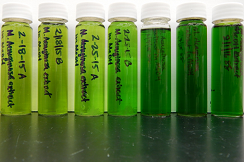Harmful Algal Blooms Mitigation and Treatment Research

Harmful algal blooms (HABs) occur when algal (or cyanobacteria) populations are dense enough that it results in adverse environmental or health outcomes. The biomass from HABs alone can raise treatment costs for drinking water, cause dead zones in waterbodies and have significant economic impacts. The cyanobacteria in some blooms can produce dangerous toxins, such as microcystins and cylindrospermopsins, that can cause significant health effects and mortality. It is imperative to avoid these negative effects through the prevention of bloom formation and, once blooms have formed, the treatment of water to prevent contamination of drinking water or ingestion through recreation, as well as many other human and ecological ill effects. However, due to the complexity of HABs formation and compounding factors such as increasing temperatures, they can be difficult to prevent. Once HABs form, they can be difficult to manage or treat due to limitations in site-specific characteristics and treatment requirements
EPA is developing best practices to prevent, treat, and manage HABs that could include bloom treatment techniques and the optimization of drinking water treatment practices. This work helps to inform management and response actions, including water body management plans, design and purchasing of in situ treatment supplies and equipment, and the design and selection of drinking water treatment processes.
Examples of this research include the following:
- Testing biological bloom control measures in source water.
- Using metabolic signals to guide the timing of bloom control measures.
- Developing and testing a low-cost engineered media to remove nitrogen and phosphorous from wastewater.
- Evaluating how algicide exposure affects cyanobacterial responses to drinking water treatment.
- Develop an accessible laboratory procedure to screen the best powdered activated carbon (PAC) and best optimal dose for treating HAB-affected drinking water.
- Evaluating efficient methods of quantifying toxins in water treatment waste streams.
Related Research
- Approaches to Reduce Nutrient Loadings for Harmful Algal Blooms Management (STAR Grantee Research)
- Harmful Algal Blooms Monitoring and Remote Sensing Research
- Harmful Algal Blooms and Drinking Water Treatment
- Data Mining and Harmful Algal Blooms
- Toxicology of Cyanobacteria
- Epidemiology and Health Effects of Cyanobacteria
- Source Water
